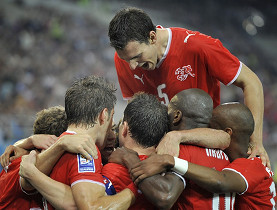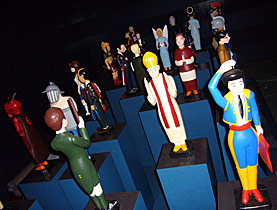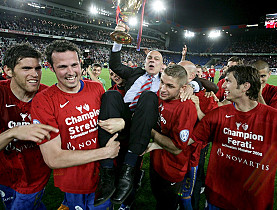The Swiss roots behind FC Barcelona

Although Barcelona have just beat Basel 5-0 in the Champions League, both teams can look back on a common thread in their histories - Swiss player Hans Gamper.
The teams, which played a C group match in Basel on Wednesday, sport virtually identical red and blue kits that may have been influenced by Gamper at the turn of the century.
Born in Winterthur, Gamper went on to found FC Barcelona in 1899 and served as its club president five times between 1908 and 1925.
Before emigrating to Catalonia he was also a long-time player for FC Basel.
Gamper is thought to have brought the colours – blue and either red or yellow – from the Basel team to Catalonia, although there is little evidence.
“There are many theories about the Barcelona colours but that of Gamper appears to be the most credible,” Manual Tomas, head of the FC Barcelona centre for documentation and studies, told swissinfo.
“But even if this explanation seems logical, no proof has ever been found and the exact origin of the club colours remains unknown.”
A fusion of colours
During Gamper’s first match in Barcelona, before the club was founded, he was wearing a blue and red cap.
Others believe that the famous “azulgrana” mixed blue and red jersey of the Catalan club could be a fusion of colours of teams Gamper played for in Switzerland: Excelsior (blue and red), Zurich (white and blue), Basel (blue and dark red), as well as the Swiss flag (a white cross on a red background).
During his different mandates as head of FC Barcelona, Gamper came under numerous attacks for being a Protestant and a foreigner.
The First World War had also significant repercussions on his life. As a German-speaking Swiss he was criticised for being pro-German and his trading business was affected by the instability of maritime routes.
Exile
His passion for FC Barcelona would lead him into exile. In 1925, spectators at the Les Corts stadium in Barcelona booed the Spanish anthem and gave an ovation to the English one. Gamper found himself accused of fighting for the independence of Catalonia, which did not go down well with Miguel Primo de Rivera’s dictatorial regime.
Gamper was then thrown out of Spain. “As a condition for him to return, the authorities forbade all contact with his club. This ostracizing was very difficult for him to deal with and he entered a deep depression,” said Tomas.
The five years that followed were terrible for him and ended with his death in 1930.
“The Great Depression of 1929, which completely ruined him, delivered the fatal blow,” added Tomas.
Another Spanish dictatorship, that of Francisco Franco, would once again weigh down on Gamper after his death. In 1955, the club decided to give his name to the new FC Barcelona stadium as a sign of appreciation – a decision opposed by Franco.
“Gamper had been a foreign citizen who committed suicide, a Protestant, a liberal ideologist and advocate of independence for Catalonia. The cherry on the cake was that he changed his Swiss-German name Hans to the Catalan ‘Joan’,” explained Tomas.
“For the dictator, Joan Gamper was a taboo subject.”
Trophy
While in Barcelona, Gamper had become well accustomed to local life.
“He was a symbol of integration and perfectly understood the identity of the region. He learned Catalan before Castillan Spanish and his speeches were always written in Catalan,” said Tomas.
His recognition would come much later. The Joan Gamper trophy was created in 1966 in his memory. This tournament is now considered one of the most important in Europe and is contested each year by several teams.
Emma Gamper, his granddaughter also published a book about him, From Hans Gamper to Joan Gamper: An Emotional Biography. A club delegation took part in the book promotion.
On June 1, 2006 the Catalan club inaugurated its new sports club and it was christened in Gamper’s name. Located on the outskirts of Barcelona, the 140,000m2 Joan Gamper centre hosts training and competitions between the different FC Barcelona football teams as well as training for other disciplines practised by the club.
The FC Barcelona historic museum has also opened the temporary Joan Gamper Exhibition, 1877-1930: the Men, the Club, the Country, so fans can learn more about the club’s founding figure.
The idea of creating a space consecrated to the achievements of the club dates back to the 1920s, a suggestion Gamper originally made to the club directors.
swissinfo, Ivan Turmo
Hans Gamper was born in Winterthur in 1877 and later moved with his family to Zurich.
An all-round sportsman, he competed in cycling, athletics, rugby, football, tennis and golf.
In 1885 he was considered the best athlete and fastest cyclist in Zurich. He played for the Excelsior, Basel and Zurich football clubs, which he founded.
At the age of 18 he left for Lyon where he played rugby and football.
He went onto Barcelona in 1898 where he wrote sports stories for two Swiss daily newspapers.
As a Protestant he was connected to the Swiss Protestant church. Together with 36 other young Protestants he set about forming a football club that would go onto become FC Barcelona.
He headed the club from 1909, was made president five times and had ties to it for 25 years.
In 1925, he was expelled from Spain by the dictator Primo de Rivera, accused of supporting Catalonian independence.
In 1930 he shot himself in the presence of a friend.

In compliance with the JTI standards
More: SWI swissinfo.ch certified by the Journalism Trust Initiative



You can find an overview of ongoing debates with our journalists here. Please join us!
If you want to start a conversation about a topic raised in this article or want to report factual errors, email us at english@swissinfo.ch.